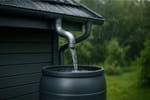Reducing energy use isn’t just about lowering your utility bills—it’s about making your home smarter, more efficient, and more comfortable year-round.
Many homeowners assume they have to invest thousands of dollars in upgrades to see real results, but the truth is, even simple tweaks can create noticeable savings.
With energy costs climbing and environmental concerns becoming more urgent, now is the perfect time to learn practical, proven ways to save energy at home without sacrificing comfort or convenience.
We’ll walk you through 10 smart, actionable strategies you can start using today.
Each method combines cost-saving tips, best practices, and hands-on examples so you can immediately apply them.
Whether you’re looking to cut costs fast or adopt a more sustainable lifestyle, these steps will help you build long-term energy efficiency that benefits your wallet and the planet.
1)) Seal Drafts and Insulate Like a Pro
Air leaks and poor insulation are silent money-drainers. Warm or cool air escaping through cracks, gaps, or uninsulated areas forces your heating and cooling systems to work harder than necessary.
As a result, your utility bills spike, and your comfort level drops.
Addressing drafts and insulation is one of the most cost-effective ways to save energy at home and can often pay for itself within a season or two.
Quick Checklist for Detecting Drafts
- Inspect doors and windows with your hand—if you feel a breeze, air is escaping.
- Check attics and basements; these are notorious for heat loss.
- Look for gaps around chimneys, vents, and electrical outlets.
Best Practices for Sealing and Insulating
- Use weatherstripping for doors and caulking for windows.
- Add insulation to attics, crawl spaces, and walls.
- Invest in insulated curtains or shades to reduce heat transfer.
Example: A homeowner in a 2,000 sq. ft. house reduced winter heating costs by 15% simply by sealing window leaks and adding attic insulation. That translates into $300 in savings annually.
2)) Upgrade to Energy-Efficient Appliances
Old appliances can be major energy hogs. Refrigerators, washing machines, and dishwashers designed 10–15 years ago consume far more power than modern, ENERGY STAR-rated models.
Upgrading your appliances may feel like a big expense, but the savings on monthly bills—and the extended lifespan of efficient units—make it a smart long-term investment.
Appliance Upgrade Hacks to Keep in Mind
- Refrigerators: ENERGY STAR models use about 15% less energy.
- Washers/Dryers: High-efficiency units use less water and power per load.
- Dishwashers: Modern models save up to 5,000 gallons of water annually.
Resource Tip
Visit energystar.gov for a searchable database of certified appliances, rebates, and tax credits in your area.
Pro Tip: If replacing appliances isn’t in your budget yet, maximize efficiency by running full loads, using eco-modes, and unplugging small devices when not in use.
3)) Switch to LED Lighting
Lighting accounts for a surprising percentage of household electricity use.
Traditional incandescent bulbs not only consume more energy but also produce heat, adding to your cooling load in summer.
Switching to LED bulbs is one of the fastest and cheapest ways to save energy at home.
Why LEDs Are a Game-Changer
- Last up to 25,000 hours (compared to 1,200 for incandescent).
- Use up to 80% less energy.
- Available in warm and cool tones for any ambiance.
Smart Lighting Tips for Homeowners
- Install dimmer switches for customizable brightness.
- Use motion-sensor lights in hallways, basements, and outdoor spaces.
- Combine LEDs with smart plugs or timers for added control.
Example: Replacing just 20 bulbs with LEDs could save an average household about $200 per year in electricity costs.
4)) Harness the Power of Smart Thermostats
Heating and cooling account for nearly half of a typical household’s energy costs.
A programmable or smart thermostat gives you precision control, ensuring you’re not wasting energy when you’re away or asleep.
This one device alone can cut your annual heating and cooling bills by up to 10%.
Smart Thermostat Best Practices
- Program different temperature settings for weekdays and weekends.
- Set winter heating at 68°F while awake and 62°F at night.
- Adjust summer cooling to 78°F when at home, and higher when away.
Checklist Before Buying
- Make sure it’s compatible with your HVAC system.
- Look for ENERGY STAR certification.
- Choose models with mobile apps for remote control.
Real-Life Example: Families with irregular schedules find smart thermostats particularly useful, as the system learns patterns and adjusts automatically.
5)) Optimize Water Heating Efficiency
Water heating is the second-largest energy expense in most homes.
A few simple adjustments can slash these costs. From lowering your water heater temperature to insulating the tank, small changes add up to big savings.
Energy-Smart Water Heater Tips
- Set the thermostat to 120°F (safe and efficient).
- Wrap older tanks in an insulation blanket.
- Fix leaky faucets—especially hot water leaks—right away.
Hot Water Usage Hacks
- Install low-flow showerheads and faucet aerators.
- Wash clothes in cold water whenever possible.
- Run dishwashers only when fully loaded.
Savings Insight: Dropping your water heater temperature from 140°F to 120°F could cut your energy use by 6–10%.
6)) Embrace Natural Light and Passive Solar Heating
Why rely on artificial lighting or extra heating when the sun can do the job for free?
Harnessing natural light and heat is an underused but effective strategy that makes your home brighter, warmer, and more inviting—without raising your bills.
Natural Light Hacks
- Keep curtains open during daylight hours.
- Use light-colored or reflective wall paint.
- Place mirrors strategically to bounce sunlight deeper into rooms.
Passive Heating Best Practices
- Open south-facing blinds on sunny winter days.
- Close curtains at night to retain warmth.
- Consider thermal curtains for enhanced insulation.
Example Worksheet Idea: Track sunny vs. cloudy days for a month and note indoor comfort levels. This helps you optimize when to open or close window coverings.
7)) Maintain HVAC Systems for Peak Performance
Your heating, ventilation, and air conditioning (HVAC) system is like the engine of your home.
Without proper maintenance, it burns more energy, works less effectively, and costs more to operate.
Routine care is one of the most practical ways to save energy at home while extending the lifespan of costly equipment.
Homeowner HVAC Checklist
- Change filters every 1–3 months.
- Schedule professional tune-ups twice a year.
- Clean vents and ensure furniture doesn’t block airflow.
Maintenance Hacks
- Use a programmable thermostat (see Tip #4).
- Seal duct leaks with foil tape or mastic sealant.
- Upgrade to a high-efficiency unit if your system is 15+ years old.
Warning: Skipping maintenance may lead to higher bills, poor indoor air quality, and even system breakdowns in extreme weather.
8)) Use Power Strips to Eliminate Phantom Loads
Even when turned off, electronics like TVs, gaming consoles, and chargers draw small amounts of power.
These “phantom loads” add up, costing the average household $100–$200 annually. The simplest fix? Smart or advanced power strips.
How Smart Strips Work
- Automatically cut power to devices when not in use.
- Include “always-on” outlets for essential devices like routers.
- Some models come with timers or remote controls.
Power-Saving Swipes
- Group entertainment devices on one strip.
- Use another for office electronics.
- Place strips in accessible areas to encourage regular shutoffs.
Pro Tip: Plugging multiple devices into one power strip not only makes surge protection easier but also safeguards your electronics from sudden voltage spikes, reduces the risk of damage during storms, and extends the lifespan of your equipment—all while simplifying energy management.
9)) Rethink Laundry Habits
Laundry may seem like a small chore, but it can have a big impact on your energy use.
By making a few simple adjustments to how and when you wash and dry clothes, you can save money while still keeping your wardrobe fresh and clean.
Energy-Smart Laundry Hacks
- Wash with cold water 80–90% of the time.
- Run full loads instead of partial ones.
- Air-dry clothes whenever possible.
Dryer Efficiency Tips
- Clean the lint trap after every load.
- Use dryer balls to reduce drying time.
- Avoid over-drying; use moisture sensors if available.
Example: A family of four switched to cold-water washing and air-dried half of their loads each week. Result? Nearly $150 saved annually.
10)) Go Green with Renewable Energy Options
If you’re ready to take your energy savings to the next level, consider renewable energy.
Solar panels, wind turbines, or even small-scale geothermal systems can dramatically reduce reliance on the grid while increasing your home’s value.
Renewable Options for Homeowners
- Solar Panels: The most common and often the most cost-effective.
- Community Solar: Shared solar projects that don’t require rooftop panels.
- Geothermal Heat Pumps: Efficient heating and cooling from underground sources.
Resource Guide for Getting Started
- Check local government incentives or tax credits.
- Explore financing options that require little to no upfront cost.
- Contact certified installers for home-specific quotes.
Best Practice: Start small—perhaps with solar water heating—before investing in a full photovoltaic system.
Conclusion
Saving energy at home doesn’t have to be complicated or expensive. With the right mindset and a willingness to make small, consistent changes, homeowners can cut utility bills fast while creating a more sustainable household.
From sealing drafts and upgrading appliances to embracing natural light and investing in renewables, the possibilities are endless.
Every action—no matter how small—adds up over time.
By applying even a few of these strategies, you’ll not only see lower bills but also enjoy a more comfortable and environmentally friendly home.
Download Our Free E-book!







